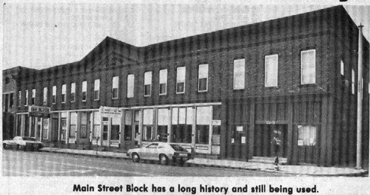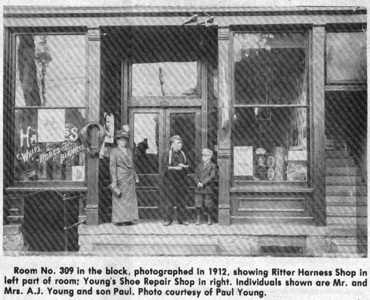October 28, 1981


Picture #1 – Main Street Block has a long History and still being used.
Picture #2 – Room No. 309 in the block, photographed in 1912, showing Ritter Harness Shop in left part of room; Young’s Shoe Repair Shop in right. Individuals shown are Mr. and Mrs. A.J. Young and son Paul. Photo courtesy of Paul Young.
There are a number of areas in the uptown business district which have not been treated by historical articles, but it is only because your author continues to search for photos to illustrate them, and has not always been successful. Nevertheless, the search continues, and occasionally old photos are discovered to support the reading matter…at least partially.
That is the case with today’s article which treats the west side of Main from South to Crocker. I am indebted Paul Young for the photo showing No. 311 in the Main Street Block.
The land in that area was originally acquired by Crocker and United State Patent Deed in 1832. Later is passed to many others in the following order: Alonzo Lockwood, Andres Brandeberry, Levi Neibel, Thomas S. Green, Samuel Scott, Andre Kizer, Rawson Crocker, Thomas Billiar and Joseph M. Doke, Oliver S. Bond, Diana Overmier, Oakdale Land Co., Alvin M. Hough, August Flechtner, William Bau, Louis Grub, Peter Grub, Christian German.
LATER OWNERS
The following data provides more recent names of owners and dates: Carl E. and Viola Mercer to Roscoe Carle (1921); August and Catherine Felchtner to Roscoe Carle (1926); Roscoe Carle to Dottie Carle, by last will (1936); Dottie Carle to Stanton Carle (1944); Stanton Carle to John Bender (1962); John Bender to Main Street Block Association, consisting of Gerald W. LaFontain, Thomas J. Sacksteder, John M. Tobin, Paul W. Wagner (1975); in 1977 Sacksteder sold out his interest to the other three partners.
The author is indebted to Gerald W. LaFontain of Main Street Block Association for use of old abstracts in researching the Main Street Block, and for compilation of the property owners list.
Early in the history of Rome (before it became Fostoria), there was a steam saw mill on one acre of land at Main and South. Originally, the land where the Main Street Block is located, was surveyed to make the lots at the corner of Main and South face South Street each being 60 feet wide and 193 1/2 feet long. At some point in time, not exactly known, not being revealed in the old abstracts, the three lots which were established by survey and known as 488, 489 and 490, became the sites for three separate buildings, all facing on Main Street. Evidently, during the resale of the original lots they were parceled off to reposition them so that the narrow dimensions faced Main and the long dimensions extended to the first alley west of Main.
THREE BUILDINGS JOINED
At another point in time, unknown, those three buildings were joined and the brick facing applied to form the appearance that building has today. John Bender, former Fostoria attorney volunteers information which was told to him by his roofing repairmen, when he owned the building, to the effect that the roof line definitely indicate that there were three separate buildings which were joined. The contractor at that time did a good job of camouflaging, to make the finished job look so perfectly like one building.
Bender also says that when Roscoe Carle owned the building, he had the second floor area completely redone, dividing it into the 12 separate residential apartments.
When the three buildings became one, the name Main Street Block was added at the top, as it is today. That building has fulfilled a need in Fostoria for perhaps close to 100 years – providing living quarters for many families on upper floors. The six business rooms have provided quarters for dispensing a variety of products and services, such as groceries, meats, tires, electrical supplies, haircuts, liquor, shoe repairs, confections, furniture, pianos, leather products and more – all of which will be discussed in this article.
POPULAR GROCERY SPOT NO. 301
Today’s historical journey starts at the corner of South and Main room No. 301. Like so many other business locations about town, that corner filled a need for a grocery at the turn of the century, or possibly before, and so a grocery it was more years than not.
John A. and Theodore S. Wonderly had established Wonderly Bros. Grocery at that location by 1902. They were still in business in 1910, perhaps longer, but the next available directory, 1915, showed Wilfred and Edmund Lonsway had taken over that location with Lonsway Bros. Grocery. They must have been in business there until 1917 or 1918 since your author often stopped there on the way to Whittier School to get bologna for his lunchbox sandwich.
The 1919-20 directory showed that room vacant. then the 1922 directory listed H. Kalify confectionary as occupying that space, but did not list the owner specifically – perhaps it was Mr. Kalify. I know nothing about Kalify perhaps a reader can tell me. At any rate, that business could not have been there longer than 1925, since that 1926 directory listed White Front Grocery as the new tenant.
The White Front Grocery was started by Ray E. Feasel and brother in-law D.R. Motts. Later, Feasel became the sole owner. By 1936 the store had been expanded to include more of the rooms adjacent to them (303-305-307). They then had departments for meats, bakery, produce and groceries.
Al Horner, who had become an employee at White Front in 1932, became owner of the store in 1948 and it continued to be known by its original name. Later, he moved it to the present location on South Street. Dale Mills bought the store from Horner and later disposed of it to the Earl Ash family.
WHITE FRONT FIRSTS
Horner reminded me that White Front was the first grocery store in town to offer self-service and motorized delivery. Also, that at one time, they made their own ice cream and chocolate candies under the supervision of Earl “Skeet” Green, and operated their own bakery. He also said they sold tons of fresh sheephead fish.
When White Front moved around the corner to the present location the Pastime Billard Parlor took over those rooms and was there until the St. Vincent DePaul Store, present occupants replaced them.
Others to occupy No. 301 were: General Auto Store; Spieldenner Carpets, and presently Catholic Social Services of Fostoria.
No. 303
Prior to White Front’s occupancy of the block of rooms, a number of others were in No. 303
William G. Peter Saloon was there in 1915. W.H. Weave, the photographer was in that room through most the years of the 1920’s. R.C. Huffman and his Legion Shoe Repair Shop shared that spot with F.A. Saliers and his Legion Barbershop in 1930-31. In 1932, the barbershop was still there, but not the shoe repair shop.
St. Vincent DePaul started there in 1971 and now occupies 303, 307 and used 311 as a warehouse.
VARIETY OF STORES NO. 305
Ithad a number of businesses through the years:
W.A. Wank-Meats in 1915; National Credit Service, J.C. Reolofs, Manager; Carbin Electric Co. (Ed. D. and Doyle Cargin, brother and father of Paul, known to many Fostorians; C.C. Cheney, Cream Station; C.W. Hall’s Cut Rate Store; Bond Restaurant; Fostoria Produce Co., and Lawn Mower Repair; Henry Peters and Charles Feindel, restaurant and grocery; Rehrig Bakery.
NO. 307
William C. Wolfe, Second Hand Furniture; Salvation Army Headquarters; Maytag Sales and Service; J.P. Gade Piano Co.; C.W. Hall Cut Rate Tire Store; W.A. King’s Fostoria Sheet Metal Co.
CHINESE LAUNDRY NO. 309
Older Fostorians will remember the Chinese Laundry that was located there, operated by different ones for many years, during the period when their services were in demand for washing and ironing men’s shirts and the detachable collars. The collars were white, stiff and highly starched.
The laundry went under the name STAR even though various Chinese came and went. Those on record were Chan Loy, Charley Dan, Charlie Jung, Lee Ling. Some of them were the objects of Mrs. E.W. Allen’s missionary efforts to enroll in the Presbyterian Sunday School.
One of the Chinese proprietors of the laundry was drowned in one of the city’s reservoirs, during that period – I don’t recall which one.
Pete Fongas, a Greek, who had a business on Main Street once told a story about his acquaintanceship with one of those Chinese. He was invited to dinner, prepared by one of them for a special holiday. The menu was duck. Pete related that the duck had been choked with the entrails left in.
Others to occupy that space (309) were: Sportsmans Shop, operated by various ones.
It was started by Howard Engler in 1946 and he operated it until November 1955; followed by Andy Veres who had it until 1975; followed by Dave Moore for about five years, when the business was discontinued.
Mrs. Engler said they took over the location from the last Chinese who had a laundry in it. “It was really a filthy room to clean up” she said. “There were still old shirts and detachable collars to dispose of, which apparently customers had never picked up.
Currently H & R Block occupies that room.
POPULAR LOCATION NO. 311
That place of business was a popular one during the early part of the century. It is still remembered by older Fostorians for at least one reason -perhaps two.
Back then, horses were an important part of America’s transportation system and used by farmers for plowing, tilling and harvesting. So, harnesses accessories and repairs were vital.
There were a number of harness makers in Fostoria then, one of them being Charles W. Rittler at No. 311. In his shop was a lifesize horse, molded of plaster of Paris. It was admired by all who visited the shop, but especially the kids who ventured in as non-customers. I’m sure many readers will wonder what ever became of the horse.
Back then the harness makers shop was frequented by anyone who needs to have a leather strap replaced, or other leather items repaired.
Reason No. 2 – Ritter shared his shop with A.J. “Andrew Jackson” Young, who had the first shoe repair shop in Fostoria in which all electric equipment was used, according to Paul Young, his son, a well-known Fostorian.
The one accompanying photo, provided by Paul Young show No. 311 back then. Mr. Young had come from Forest to Fostoria where he met and married Laura Elizabeth Bear.
In the front window of the harness shop photo can be seen a placecard with Woodrow Wilson’s picture then a presidential candidate.
In later years, Ritter shared the room with W.H. Hall, barber; also Charles Chaney’s cream station.
At another time, Mr. Young had a shoe repair shop on Perry Street, when he retired he returned to Forest.
Others to occupy No. 311 were: R.E. Balderson, barber and beauty shop; J.W. Little Shop operated by James and Kathy Watson; George Kline-Hauling contractor.